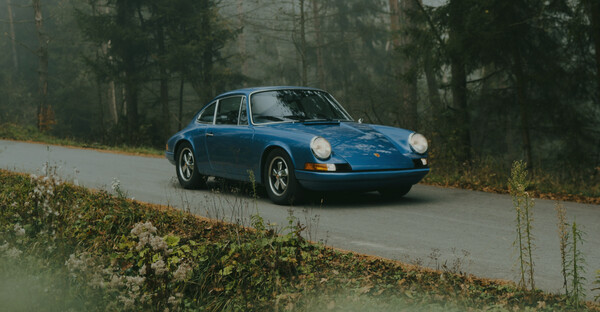Description
The XK120 was launched as an open two-seater or roadster (US) at the 1948 London Motor Show, as a test bed and show car for the new Jaguar XK engine. The show car was the first prototype, chassis number 670001. It was almost identical to the production cars, with the exception of the straight outer windscreen pillars, which were curved on the production version. The roadster caused quite a stir, persuading Jaguar founder and design boss William Lyons to put it into production, and from 1948 the first 242 cars featured an open 2-seater body with a wooden frame and aluminium panels. In early 1950, production switched to an all-steel body that was 51 kg heavier. The '120' in the name refers to the aluminium car's top speed of 193 km/ h (120 mph) (faster with the windscreen removed), which made it the fastest production car in the world at the time of its launch. In 1949, the first production roadster, chassis number 670003, was delivered to Clark Gable. The XK120 was eventually available in two open versions, first as an open two-seater described in the American market as the roadster (and designated OTS, for open two-seater, in America), then also as a convertible coupé (DHC) from 1953; and also as a closed, or fixed-head, coupé (FHC) from 1951.
On 30 May 1949, on the empty Ostend-Jabbeke motorway in Belgium, an XK120 prototype timed by officials of the Royal Automobile Club of Belgium achieved an average oncoming speed of 132. 6 mph with the windscreen replaced by a single small aerosol and a catalogued alternative top gear, and 135 mph with a passenger-side tonneau cover in place. In 1950 and 1951, on a sloping oval circuit in France, XK120 roadsters averaged over 100mph for 24 hours and over 130mph for one hour. In 1952, a fixed-head coupe broke numerous world speed and distance records by averaging 100mph for a week. Roadsters were also successful in racing and rallying. The first roadsters, hand-built with aluminium bodies on ash frames mounted on modified Jaguar Mark V chassis, were built between late 1948 and early 1950. To meet demand, and from the 1950 model year onwards, all subsequent XK120s were mass-produced with pressed steel bodies. The doors, bonnet and boot lid were made of aluminium. The DHC and FHC versions, more luxurious than the roadsters, featured wind-up windows and wood veneers on the dashboard and interior door trim. With its alloy cylinder head, hemispherical combustion chambers, angled valves and twin SU side-draft carburettors, the XK's 3. 4-litre in-line six-cylinder DOHC engine was relatively advanced for a mass-produced unit at the time. With a standard compression ratio of 8:1, it produced 160 bhp (119 kW) on 80 octane fuel. Most of the early cars were exported; a lower-compression 7:1 version, with reduced performance, was reserved for the UK market, where the post-war austerity measures then in force restricted buyers to 70-octane 'Pool petrol'. The Jaguar factory, which had access to 80-octane fuel, supplied the press with roadsters with the highest compression ratio. Journalists were then able to test the model's optimum performance in Belgium, on a long straight between Jabbeke and Ostend. The XK's basic engine design, later modified into 3. 8-litre and 4. 2-litre versions, survived into the late 1980s. All XK120s were equipped with independent torsion-bar front suspension, semi-elliptic leaf springs at the rear, recirculating ball steering, telescopically adjustable steering column and 12-inch drum brakes all round, which tended to fade.
The roadster's lightweight canvas soft top and removable side windows stowed out of sight behind the seats, and its barchetta-style doors had no external handles; instead, there was an internal pull tab accessible via a flap in the side windows when the weather equipment was in place. The windscreen could be removed to allow aerodynamic windscreens to be fitted. This example has been fully restored and has not been driven since!

















